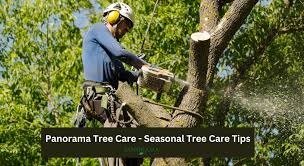
Taking care of trees contributes to their overall health, beauty, and long-term survival. Arborists offer valuable advice on how to care for trees throughout the year. Here are some practical recommendations to support the healthy growth of your trees in every season:
Rejuvenation and Growth
Spring is a significant season in tree care as it marks the end of winter dormancy, prompting proper attention for optimal growth. Arborists advise conducting a thorough inspection to assess any winter-induced damage, diseases, or pests affecting the trees. Pruning is optimal during this time to remove dead or damaged branches, fostering healthy growth. Applying balanced fertilizer aids in providing proper nutrients, while mulching around the base of trees helps maintain optimal soil moisture and temperature for root development.
Spring presents an opportune time for planting new trees. Choosing species native to the region will help to encourage long-term health and resilience against local climate and soil conditions. Arborists emphasize proper planting techniques, such as digging an appropriately sized hole and planting at the correct depth. These practices promote the successful establishment and growth of new trees.
Maintenance and Monitoring
During summer, trees face various challenges such as high temperatures, water scarcity, and potential pest issues. Proper irrigation will help trees withstand these conditions. Deep watering makes sure that moisture reaches the root zone, encouraging the development of deep roots. This enhances the tree’s drought resistance. Mulching is beneficial as it aids in moisture retention and regulates soil temperatures.
Throughout summer, it is advisable to monitor for pests and diseases. Common pests such as aphids, caterpillars, and borers can pose significant threats to tree health and productivity if left unchecked. Vigilance in pest management helps prevent potential losses. Avoid pruning during summer as it can stress trees and make them more susceptible to heat-related damage.
Preparation for Dormancy
Fall is a period when trees prepare to enter dormancy. Professionals recommend making sure trees are adequately hydrated until the soil freezes, which helps prevent dryness during cold or dry spells. Conducting a soil test in the fall can optimize nutrient levels before the growing season resumes. Selective pruning in autumn targets dead or diseased branches, promoting tree health and reducing the risk of breakage under snow or ice loads. This practice not only enhances the tree’s appearance but enhances its structural integrity.
Clear away fallen leaves and debris from around the base of trees to prevent potential fungal growth or pest habitat. Inspect trees for structural issues, such as weak branches or leaning trunks, to make sure they can withstand winter weather conditions. This proactive approach in the fall helps trees enter dormancy in optimal condition, ready to thrive when spring returns.
Hire Certified Arborists
Proper tree care throughout the year encourages good health and enhances their lifespan. Professional arborists play a key role in maintaining trees’ beauty and health, ultimately improving landscape aesthetics and air quality. Each season—spring, summer, autumn, and winter—has specific tree care needs. Consulting with a professional is recommended for personalized advice and services.






